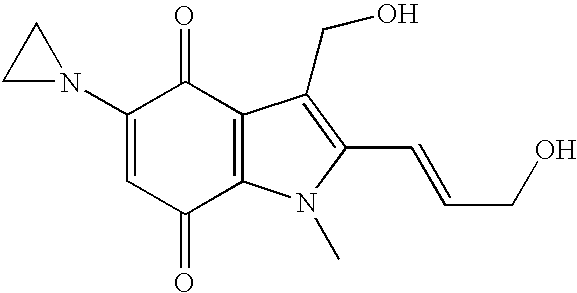Intravesical apaziquone administration following transurethral resection
a transurethral resection and apaziquone technology, applied in the field of bladder cancer treatment, can solve problems such as patient inconvenien
- Summary
- Abstract
- Description
- Claims
- Application Information
AI Technical Summary
Benefits of technology
Problems solved by technology
Method used
Image
Examples
example 1
[0034]In a first study using intravesical administration, EOquin® was given to 12 patients with SBC, TNM stages Ta or T1, histologic grade G1 or G2. All patients had recurrent, multiple (2 to 10) superficial tumors of which all but one “marker lesion”, 0.5-1 cm in diameter, were excised by transurethral resection (TUR-BT) prior to the trial. Tumor response was defined as complete response (CR), no response (NR) or progressive disease (PD) confirmed by cystoscopy and histology (biopsy of the initial marker lesion site, or complete resection of any residual or new lesion) four weeks after the last instillation. EOquin® was given weekly for six weeks, starting two weeks after TU R-BT.
[0035]In the phase I part of the study, six patients were treated with EOquin® concentrations that were increased weekly by 100% (0.0125 mg / mL; 0.025 mg / mL; 0.05 mg / mL; 0.1 mg / mL; 0.2 mg / mL; and 0.4 mg / mL and in this particular example, 0.5, 1, 2, 4, 8 and 16 mg in 40 mL). Following the determination of a ...
example 2
[0038]This study was a multi-center, non-randomized, open-label phase II study in patients with primary or recurrent, multiple (2-10) lesions of Ta or T1, G1 or G2 transitional cell SBC. Patients had undergone TUR-BT of all but one (marker) lesion, 0.5-1 cm in diameter, before study entry.
[0039]Instillations were performed weekly for six weeks. Tumor response was confirmed by biopsy, or complete resection of any residual tumor, two to four weeks after the last instillation. Tumor response was assessed as complete response (CR), no response (NR) or progressive disease (PD).
[0040]Of 46 patients entered, 37 had recurrent SBC. More than 50% of the patients had prior TUR-BT plus intravesical immunotherapy and / or chemotherapy. In total 17% had undergone TUR-BT alone and 17% had received no prior treatment. Tumor grade was reclassified as G3 at histology review in two patients.
[0041]Efficacy. Tumor response was 31 CR in 46 patients (67%). There were no cases of “progressive disease”, i.e.,...
example 3
[0044]Traditionally, adjuvant instillation treatment was started approximately 2 weeks after TUR-BT. The practice of a single instillation given within the 6 hours (from the time when TUR-BT is performed to about 6 hours after TUR-BT) following TUR-BT is more recent. “Immediate” (within 6 hours) or same-day post-TURBT intravesical instillation of cytotoxic agents was employed in Europe without reports of excessive toxicity when compared to those receiving treatment 2 or more weeks following TURBT. As Examples 1 and 2 demonstrate, EOquin® as a single agent is safe and generally well tolerated at a dose of 0.1 mg / mL (here, 4 mg in 40 mL), given weekly for 6 consecutive weeks in patients who have undergone TUR-BT, starting approximately 2 weeks after TUR-BT.
[0045]This study assessed the tolerability and safety of administering EOquin® immediately (i.g. within about 6 hours) following TUR-BT in patients with superficial bladder cancer. Plasma levels were measured in patients at selected...
PUM
| Property | Measurement | Unit |
|---|---|---|
| Time | aaaaa | aaaaa |
| Time | aaaaa | aaaaa |
| Time | aaaaa | aaaaa |
Abstract
Description
Claims
Application Information
 Login to View More
Login to View More - R&D
- Intellectual Property
- Life Sciences
- Materials
- Tech Scout
- Unparalleled Data Quality
- Higher Quality Content
- 60% Fewer Hallucinations
Browse by: Latest US Patents, China's latest patents, Technical Efficacy Thesaurus, Application Domain, Technology Topic, Popular Technical Reports.
© 2025 PatSnap. All rights reserved.Legal|Privacy policy|Modern Slavery Act Transparency Statement|Sitemap|About US| Contact US: help@patsnap.com

